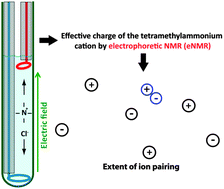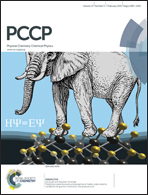Ion association in aqueous and non-aqueous solutions probed by diffusion and electrophoretic NMR†
Abstract
The results of diffusion and electrophoretic NMR (eNMR) measurements are reported for a series of tetramethylammonium (TMA) electrolytes (with sulphate, fluoride, acetate, chloride, bromide, nitrate, iodide and perchlorate as anions) in deuterated solvents such as water, dimethylsulphoxide (DMSO), acetonitrile, methanol and ethanol. In addition, similar data are presented for aqueous solutions of tetraalkylammonium salts with increasing alkyl chain length. The combination of diffusion NMR and eNMR yields the effective charge for the TMA cation. Relative to the nominal charge of znom = 1 of TMA, the effective charge in the different solvents is found to be progressively smaller in the order water > DMSO > methanol > acetonitrile > ethanol. A part of this observed trend is ascribed to regular ion–ion interactions incorporated in the Onsager limiting law. Indeed, in solvents with high dielectric constants such as water, DMSO and methanol, the Onsager limiting law describes well the observations for all tetraalkylammonium ions. For ethanol and acetonitrile, there is a significant difference between the experimental data and the expected limiting-law behavior that is attributed to ion association (ion pairing) not taken into consideration by the Onsager limiting law.


 Please wait while we load your content...
Please wait while we load your content...